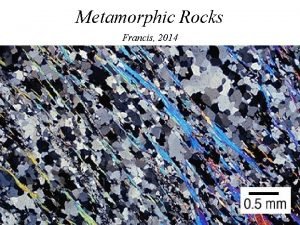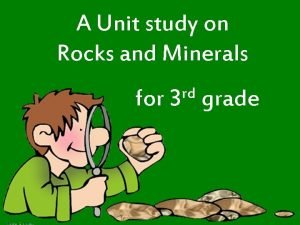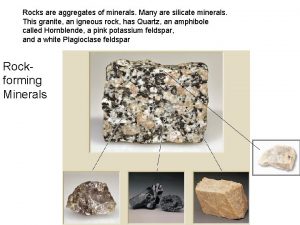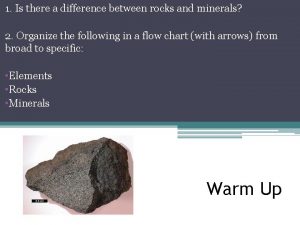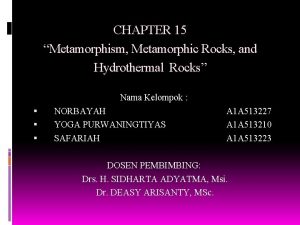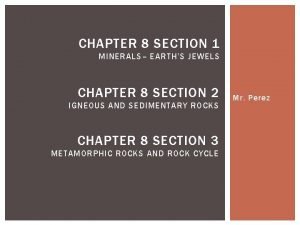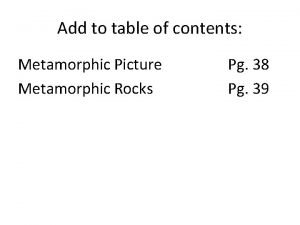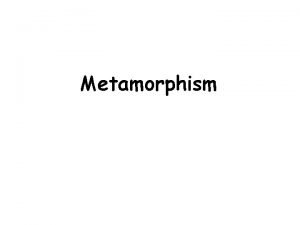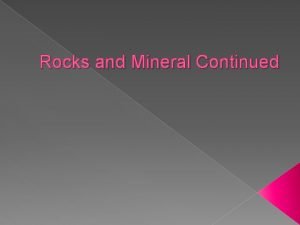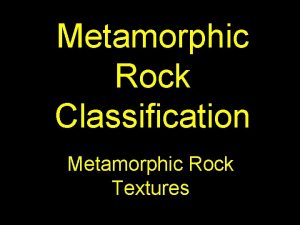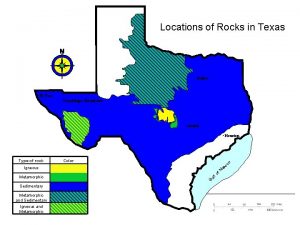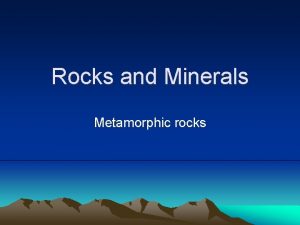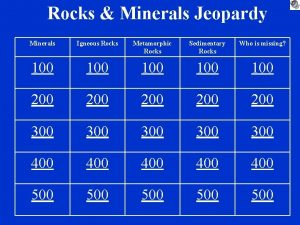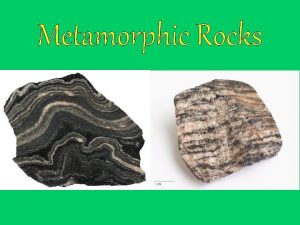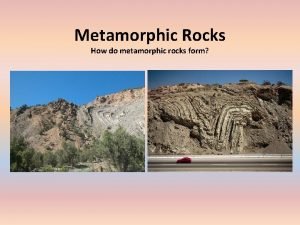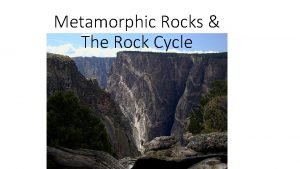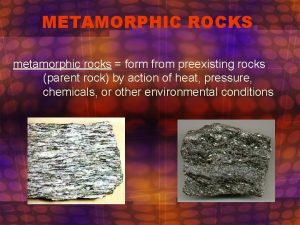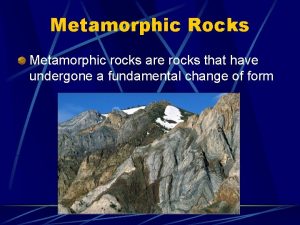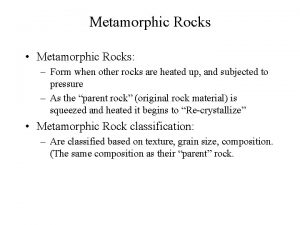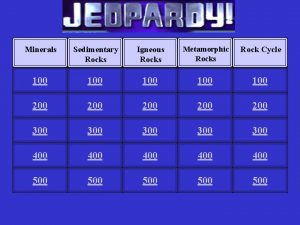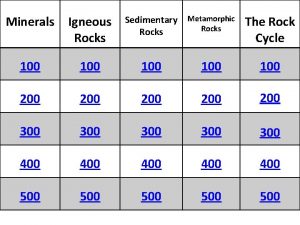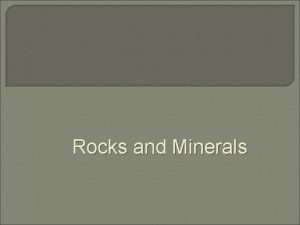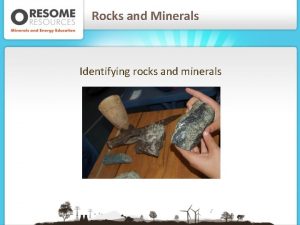Metamorphic Rocks Francis 2014 Metamorphic Minerals andalusite AFM
























- Slides: 24

Metamorphic Rocks Francis, 2014

Metamorphic Minerals andalusite AFM projection for Metapelites sillimanite kyanite paragonite muscovite pyrophyllite Na. Al 2(Al. Si 3 O 10(OH)2 KAl 2(Al. Si 3 O 10(OH)2 Al 2 Si 4 O 10(OH)2 andalusite kyanite sillimanite Al 2 Si. O 5 or Al 2 OSi. O 4 staurolite (Fe, Mg)2 Al 9 O 6(Si. O 4)4(O, OH)2 chloritoid cordierite (Fe, Mg)2 Al 4 O 2(Si. O 4)2(OH)4 (Fe, Mg)2 Al 3(Al, Si 5)O 18. n. H 2 O garnet chlorite biotite (Fe, Mg)3 Al 2(Si. O 4)3 (Mg, Fe)3(Al, Si 3)O 10(OH)2 (Mg, Fe)3(OH)6 KFe 3(Al. Si 3 O 10(OH)2 zoisite - epidote tremolite/ actinolite Ca 2(Fe, Al)3 O(Si. O 4)(Si 2 O 7)(OH) Ca 2(Fe. Mg)5 Si 8 O 22(OH)2 staurolite

Andalusite Chlorite Garnet /Biotite Cordierite / Pyrox Kyanite Staurolite Sillimanite Actinolite Hornblende Muscovite K-Spar

Metamorphic Facies : A metamorphic facies is the set of mineral assemblages that are stable over a given range of P and T. The actual mineral assemblage within this set that a given rock exhibits is a function of its chemical composition. The delineation of the metamorphic facies commonly used today is a matter of historical development that predates actual experimental determination of pressures and temperatures. The division of the P-T metamorphic regime into the following metamorphic facies developed from field observations on the persistence of certain mineral assemblages for specific bulk compositions in geographic and thus P-T space: Zeolite - zeolites or clay minerals, calcite and/or quartz-filled amygdules Greenschist - green minerals: chlorite, actinolite, epidote Blueschist - blue amphibole, aragonite Amphibolite - dark amphibole (hornblende), garnet Granulite - absence of hydrous minerals and thus schistoscity, granular Eclogite - pyropic garnet & jadeiitic clinopyroxene – high pressure

Slate vs Shale Harder and cleavage at an angle to bedding Extremely fine-grained rock exhibiting a perfect planar cleavage defined by the alignment of sub-microscopic phyllosilicates grains. be d g n i d Distinguished from shale by its greater hardness and the fact that cleavage is generally at an angle to bedding.

Phylites to Schists micaceous foliation with sheen or visible mica xyls cordierite muscovite schist garnet muscovite schist

Schists

kyanite staurolite schist garnet staurolite schist andalusite sillimanite Metapelites in the Amphibolite Facies No amphiboles because of the lack of Ca kyanite

amphibolites basaltic bulk compositions garnet Hornblende Plag Typically characterized amphibole-defined lineation, rather than mica-defined foliation

Amphibolites Hornblende garnet Plag

Gneissosity: Compositional layering produced by metamorphic (solid-state) segregation into alternating felsic (leucosomes) and mafic (melanosomes) layers. Gneiss

Gneiss

Feldspar is granular rather than lath-like. garnet-orthopyroxene-cordierite granulite garnet sillimanite gneiss granulite andalusite sillimanite kyanite

partial melting migmatites and diatextites

diatexite, Hortavaer Complex, Norway partial melting migmatites and diatextites

Metamorphosed Carbonates marble: skarn: crystalline metamorphosed limestone. calcium-rich contact-metasomatic rock – contains abundant calc-silicate minerals ± carbonate formed at the contacts between magmatic intrusions and dirty carbonate rocks. Diopide Grossularite Calcite Ca. Mg. Si 2 O 6 Ca 3 Al 2(Si. O 4)3 Ca. CO 3 Gross

High-pressure rock of basaltic composition dominated by pyropic garnet (Mg 3 Al 2(Si. O 4)3) and jadeitic (Na. Al. Si 2 O 6) clinopyroxene kyanite (never sillimaniteassociated, with of diamonds. More mafic compositions of with similar mineralogy are termed garnet clinopyroxenites. Eclogite andalusite sillimanite kyanite

Mylonite / Tectonite Extremely fine-grained rock exhibiting fine parallel gneissic banding over extensive strike lengths, produced by extreme strain. Typically possess a pronounced mineral lineation parallel to the transport direction, commonly have rotated porphyroblasts

Metapelites AFM Projections Shales are typically depleted in Ca and Na because they were lost to solution during the breakdown of tecto-, ino-, and orthosilicates to clay minerals during weathering. Furthermore, quartz and muscovite are typically ubiquitous phases in metapelites. As a result, we can project the compositions of metapelites into a simplified ternary system (end-members: Al 2 O 3* (A), Fe. O (F), and Mg. O (M)), assuming that quartz and muscovite are always present. Components = 6: K 2 O, Al 2 O 3, Si. O 2, Fe. O, Mg. O, H 2 O With excess quartz & water: C = 4 and F = 4 - P + 2 If muscovite is present, we can project the mineral assemblages onto the Al 2 O 3 – Fe. O – Mg. O plane, where: C = 3 and F = 3 - P + 2 thus F = 0 for P = 3, if Press & Temp are fixed


Metapelite Minerals: quartz, muscovite, and : andalusite kyanite sillimanite Al 2 Si. O 5 or Al 2 OSi. O 4 pyrophyllite Al 2 Si 4 O 10(OH)2 paragonite Na. Al 2(Al, Si 3)O 10(OH)2 muscovite KAl 2(Al, Si 3)O 10(OH)2 staurolite (Fe, Mg)2 Al 9 O 6(Si. O 4)4(O, OH)2 chloritoid cordierite (Fe, Mg)2 Al 4 O 2(Si. O 4)2(OH)4 (Fe, Mg)2 Al 3(Al, Si 5)O 18. n. H 2 O garnet chlorite (Fe, Mg)3 Al 2(Si. O 4)3 (Mg, Fe)3(Al, Si 3)O 10(OH)2 (Mg, Fe)3(OH)6 biotite K(Mg, Fe)3(Al, Si 3)O 10(OH)2 K-feldspar KAl. Si 3 O 8

F=C-P

F=C-P

 Sedimentary rocks turn into metamorphic
Sedimentary rocks turn into metamorphic Compaction and cementation
Compaction and cementation Granulite
Granulite Andalusite
Andalusite Andalusite
Andalusite Difference between minerals and rocks
Difference between minerals and rocks Rock type
Rock type Rocks are aggregates of minerals
Rocks are aggregates of minerals Concept map on how magma is formed
Concept map on how magma is formed Rock type
Rock type Poem about minerals and rocks 3 stanza
Poem about minerals and rocks 3 stanza Rock cycle
Rock cycle What kind of rock is this
What kind of rock is this Minerals vs elements
Minerals vs elements Serpetinit
Serpetinit Metamorphic rocks drawing
Metamorphic rocks drawing How are metamorphic rocks classified
How are metamorphic rocks classified Esrt rocks
Esrt rocks Metamorphic grade
Metamorphic grade How are metamorphic rocks classified
How are metamorphic rocks classified Contact and regional metamorphism venn diagram
Contact and regional metamorphism venn diagram Bowen's reaction series
Bowen's reaction series Metamorphic rocks properties
Metamorphic rocks properties Staurolite
Staurolite Types of rocks in texas
Types of rocks in texas



